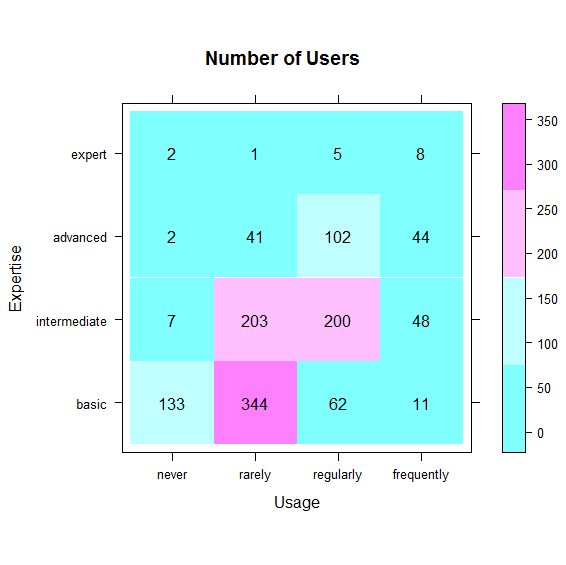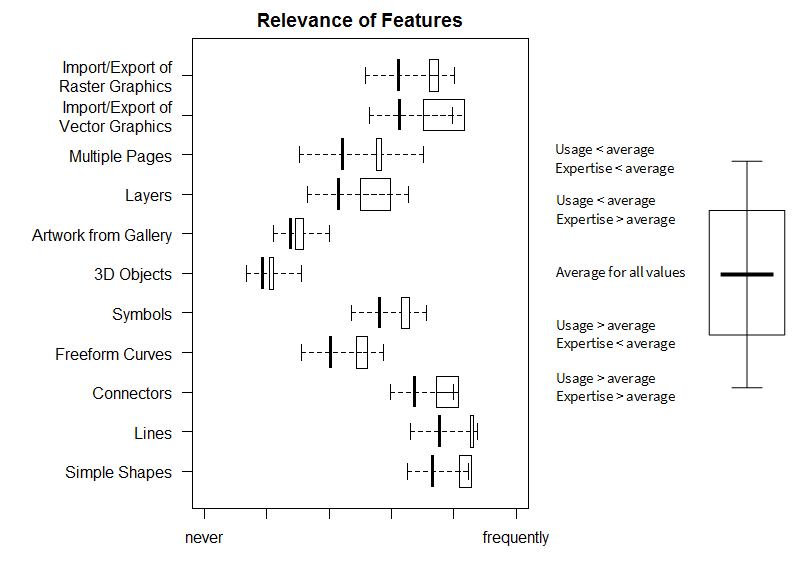In February 2016, we asked the community for what purpose LibreOffice Draw is being used and in what direction it should evolve. The response to this survey was incredible, with more than 2,000 participants answering the questionnaire and almost 1,000 of them making detailed free text statements. Thanks a lot – you are awesome!
Participants
In the first two questions of the survey we wanted to get a better idea about the participants, so we asked “How often do you run LibreOffice Draw?” and “How well do you know the application?”, both in four discrete steps.

Regarding expertise, most users rate themselves below average. Regarding usage, the participants are evenly distributed. In the next analysis we will see if expertise and usage have an impact on the relevance of features. We divided participants into above- and below-average and analyzed them separately.
Features
We then asked which features participants use with “How often do you use the following features?”.

In this type of diagram the box usually denotes the standard deviation or standard error, and the whiskers multiple of those values or extrema. Here it shows the data categorized by usage and expertise.
Simple features such as shapes and lines are used frequently, followed by connectors and symbol shapes. The import and export of files in both vector and raster formats is also very important.
Below average features are layers, multiple pages, as well as freeform curves, but only with participants who are not experts or don’t use Draw frequently. The least used features are the gallery and 3D objects.
Document size
The question “In what size are your drawings usually? (add a maximum size if you think it’s necessary)” was understood by most as related to ISO measures (as it was intended). In total, 292 answered A4 or Letter, and another 234 added ISO values between A6 and A0.

But there were also a lot of participants who told us how many bytes their drawings have (between 1-10 MB, up to 200 MB), the size as length (20 cm in average, up to 2 m), number of pages (1 page, which could be added to A4, up to 50), length in pixels (1024×786 px mostly, up to 5000×5000), or number of objects (up to 100). If there was only a number without a unit, or text that was ambiguous to interpret like “small” or “huge”, it was treated as “unclear”. And 497 participants (not shown in the figure) skipped this question.
Conclusion
In this first part of the LibreOffice Draw usage analysis, we show the variability of users and the document dimensions they assign to their drawings. In the second part we discuss for what purpose the program is used and how it is expected to evolve.

Thomas Pfeiffer suggested to replace the nasty abuse of a box-whisker plot by a simple profile plot. Here it is: https://wiki.documentfoundation.org/File:Profileplot.png (R script updated)
How can the number of users who use Lines exceed the number of users who use Simple Shapes?
Do they draw just lines connecting imported images? Or do they connect 3D objects? Or they just draw lines in random directions? This would be really interesting to know.
Or maybe participants didn’t want to understand their shapes as simple. The number of valid answers is by the way 1146 for Lines and 1140 for Simple Shapes with an average regarding how often the feature is used of 4.77 vs. 4.66 respectively. I wouldn’t take the difference as that important.
From user metrics i’ve analyzed, Line is the most used shape in the Drawing toolbar. Lines are used for example in flow charts, chemical engineering diagrams, and networking diagrams, but none of the shapes in the ‘Simple Shapes’ drop split/group button are.
I think Draw is the weak point of LibreOffice.
When one compares Word Writer, Excel Calc, Power Point Impress and Visio Draw it seems Draw is weakest competitor compared to its reference point.
I wish more resources would be invested in it. Visio 2017 as a reference point will be good.
A nice feature would be integrating Graph Sktecher based on OmniGraphSketcher which is Open Source:
https://github.com/graphsketcher/GraphSketcher
Also many great ideas can be borrowed from Ipe:
http://ipe.otfried.org/
Thank You.